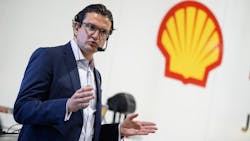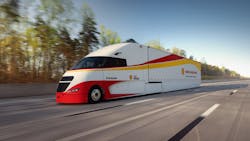Traditional fuels and the bridge to zero-emission trucks
Shell’s 80-ft. long Starship 2.0 truck, designed to glide down the road like a fish through water, was near impossible to miss in a sea of battery-electric, hydrogen fuel cell, and alternative “clean” energy projects on display at the 2021 ACT Expo. The tractor-trailer stands out not only because of its sleek look and size, but it demonstrates what is possible leveraging efficiency technologies and energy sources that are available today.
As the commercial vehicle industry readies itself for a scalable zero-emission transformation, even Shell, which has been exclusively focused on diesel, is looking at hydrogen, renewable natural gas, and biodiesel to meet the organization’s global commitment to be net-zero by 2050. In the meantime, however, the company realizes how important it is to continue to rely on traditional fuels and technologies.
“We have 10 years max to build a business, in my view, that is sustainable for the future and moves us away from the traditional products and gives us the opportunity to build more into the alternative energy space,” Patrick Carré, VP of Shell’s Commercial Road Transport Sector, pointed out during an ACT Expo Fireside Chat with Erik Neandross, Gladstein, Neandross & Associates CEO.
“For commercial road transport, I say 10 years because the technologies that we see—and I will single out both battery-electric and hydrogen on the truck side—are clearly two technologies I can see being ready and commercially available at scale in the second half of the 20s,” Carré added.
However, betting only on these two technologies alone isn't going to do the trick. Carré emphasized the importance of leveraging biofuels, renewable diesel, renewable natural gas, and technologies to begin reducing tailpipe emissions.
“I think there is an opportunity to really build that bridge over the next three to five years—maybe longer—until the true net-zero technologies hydrogen and battery-electric will be available at scale,” he said. “That is something we really have to do if we are serious about accelerating that journey. We should not limit ourselves to just one or two technologies, we should work the entire bandwidth.”
Included in its corporate portfolio, Shell’s Greenlots is focused on researching and developing an electric vehicle infrastructure ecosystem; Shell Hydrogen is working to build the infrastructure needed for hydrogen to grow as a transport fuel; and Shell RNG focuses on producing and supplying low-carbon fuels, such as biodiesel, bioethanol, and renewable natural gas.
When it comes to letting the market pick the sustainable technology winners moving forward, Carré said he is a big believer in the market playing a fundamental role in the space. But he urged the industry not to be naïve.
“There are a few things from a regulatory point of view and framework that need to happen to accelerate,” he explained. “What I mean by that is if negative CO2 emissions aren’t factored into the pricing, technology change is not going to happen. If you think about the situation today, there are many advantages that diesel technology brings. If the CO2 effect of diesel consumption doesn’t get factored into the price, it will be very difficult for other technologies to emerge. That is a role the regulators should play.”
Forging the path to zero emissions, Carré stressed that it starts with building charging infrastructure and depot facilities. Until those facilities are built out, he also emphasized the importance of establishing biofuel energy or RNG networks via partnerships.
“Commercial road transport is the absolute lifeblood of the economy and we’ve seen it during the pandemic,” Carré noted. “It is absolutely vital, and many people take it for granted, which is wrong. People who work in this space should be unbelievably proud about what they and their people do. But we have to reconcile emissions. We have to keep this lifeblood of the economy going but we have to get rid of the CO2 emissions.”
Reducing ICE emissions today
Even with today’s internal combustion engine framework, by leveraging lubrication, aerodynamics, rolling resistance, and energy conversion, the industry has already begun working to make a measurable contribution to reducing the CO2 footprint.
“Waiting for technology to scale up is not going to be good enough,” Carré said during a Shell press conference at ACT Expo. “We’ve got to be working on what we have today with the tools we have today. This is what the Starship truck embodies and demonstrates.”
Announced during the event, Shell Starship 2.0 achieved 254 ton-miles per gallon for freight ton efficiency (FTE) on its cross-country trek from San Diego to Jacksonville, Florida. This was a 3.5 times improvement over the North America average FTE for trucks which is 72 ton-miles per gallon, Shell noted. The first Starship demonstration run over the same route in 2018 yielded a freight ton improvement of 2.48 over the North American average. Both trips were monitored and verified by the North American Council for Freight Efficiency.
Shell Starship 2.0 achieved a 10.8 mpg on its cross-country run compared to the 8.94 achieved by Starship 1.0 and the 6.4 mpg North American fleet average. These numbers are made even more significant given Shell Starship 2.0 beat the 178 ton-miles per gallon for FTE achieved in 2018 while carrying an 18% increase in payload, from 39,900 lb. of clean reef material in 2018 to 47,100-lb. this year.
The Shell Starship program exceeded its 2018 results in its second cross-country run by using updated energy-efficient technologies, such as the Cummins 2020 X15 engine (EX Efficiency Series; 400-hp; 1,850 ft.-lbs. torque) paired with the Eaton Cummins Endurant transmission, to demonstrate what could be achieved driving a Class 8 truck in real-world conditions.
“What we are trying to do is move the maximum payload with the least amount of energy. We want to do this by using the most advanced and currently available technology today, and we ultimately want to maximize on our freight ton efficiency,” Ryan Manthiri, Starship project manager, explained.
Following the initial program in 2018, the Shell Lubricants Solutions and Shell Technology teams worked together to pair the learnings from the first run with recent advancements in technology to develop the Shell Starship 2.0 truck. The new truck features a new chassis and drivetrain, along with new safety and fuel-efficient upgrades while maintaining the body from the original truck.
A second, shorter 400-mile evaluation run was conducted to provide additional data about its freight ton efficiency and fuel economy benefits. The short-haul evaluation was completed in North Carolina with a cargo weight of 17.5 tons which was chosen to reflect a more typical payload, commonly used by many fleets. The average fuel economy obtained was 12 mpg and the freight ton efficiency value was 210 ton-miles per U.S. gallon. While both values are direct consequences of the reduction in cargo mass, these are significant numbers when compared to the U.S. average of 6.4 mpg and 72 ton-miles per gallon. The fuel mileage is almost double the U.S. average and the ton-miles is more than triple.
Jeff Priborsky, global marketing manager for the On-Highway Fleet Sector, Shell Lubricant Solutions, noted that market estimates say diesel fuel will still be the primary source for commercial road transport until 2050.
“Hopefully, we can make the tipping point in North America sooner, but this is a demonstration of what fleets can do now to enhance efficiency,” Priborsky said of the Starship project.
And because it will be a while longer before battery-electric and hydrogen fuel cell technologies are available at scale, Selda Gunsel, Shell’s VP of global lubricants and fuels technology, said Starship is an example of what the road transport sector can do today to improve energy efficiency
“The diesel engine will be the predominant platform for years to come, so we want to be able to enhance fuel efficiency and reduce CO2 emissions,” Gunsel told FleetOwner. “While we are working on these alternative technologies that will come into play, it’s going to take some time. Starship really shows you what we can do today by pushing the boundaries of existing technologies.”
About the Author

Cristina Commendatore
Cristina Commendatore is a past FleetOwner editor-in-chief. She wrote for the publication from 2015 to 2023.


